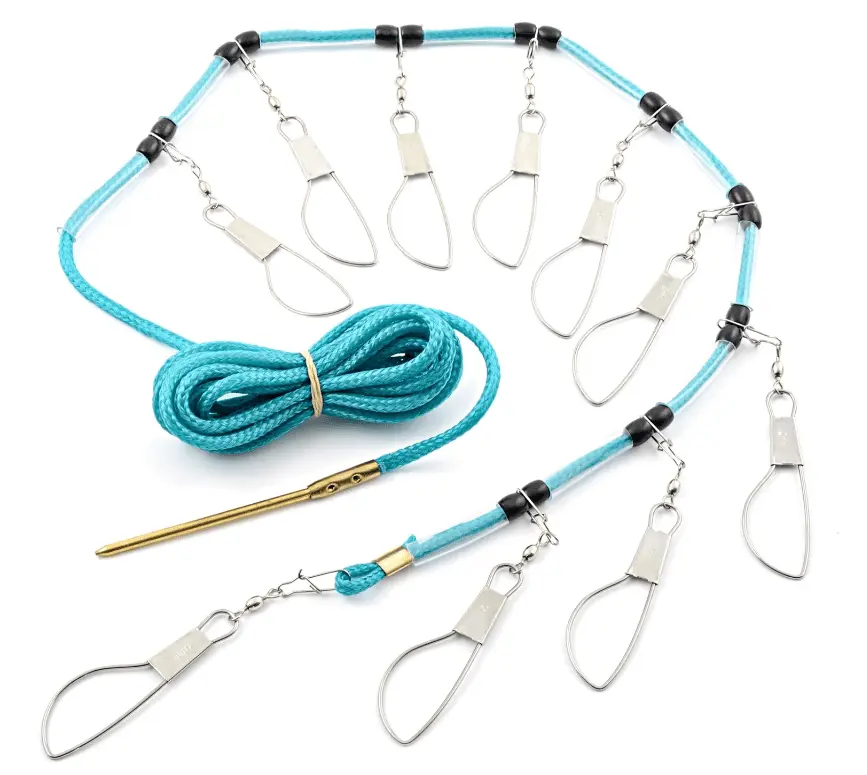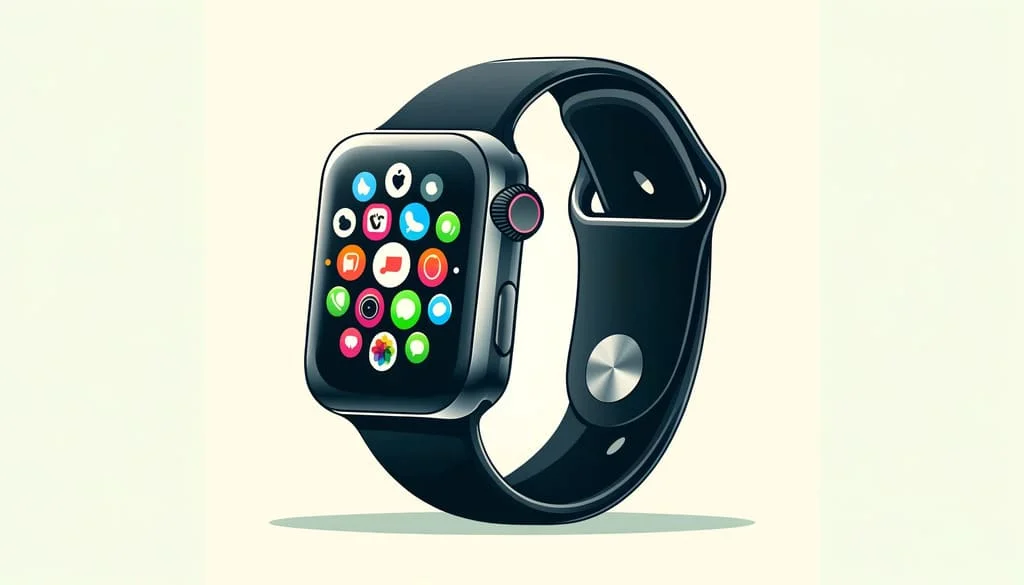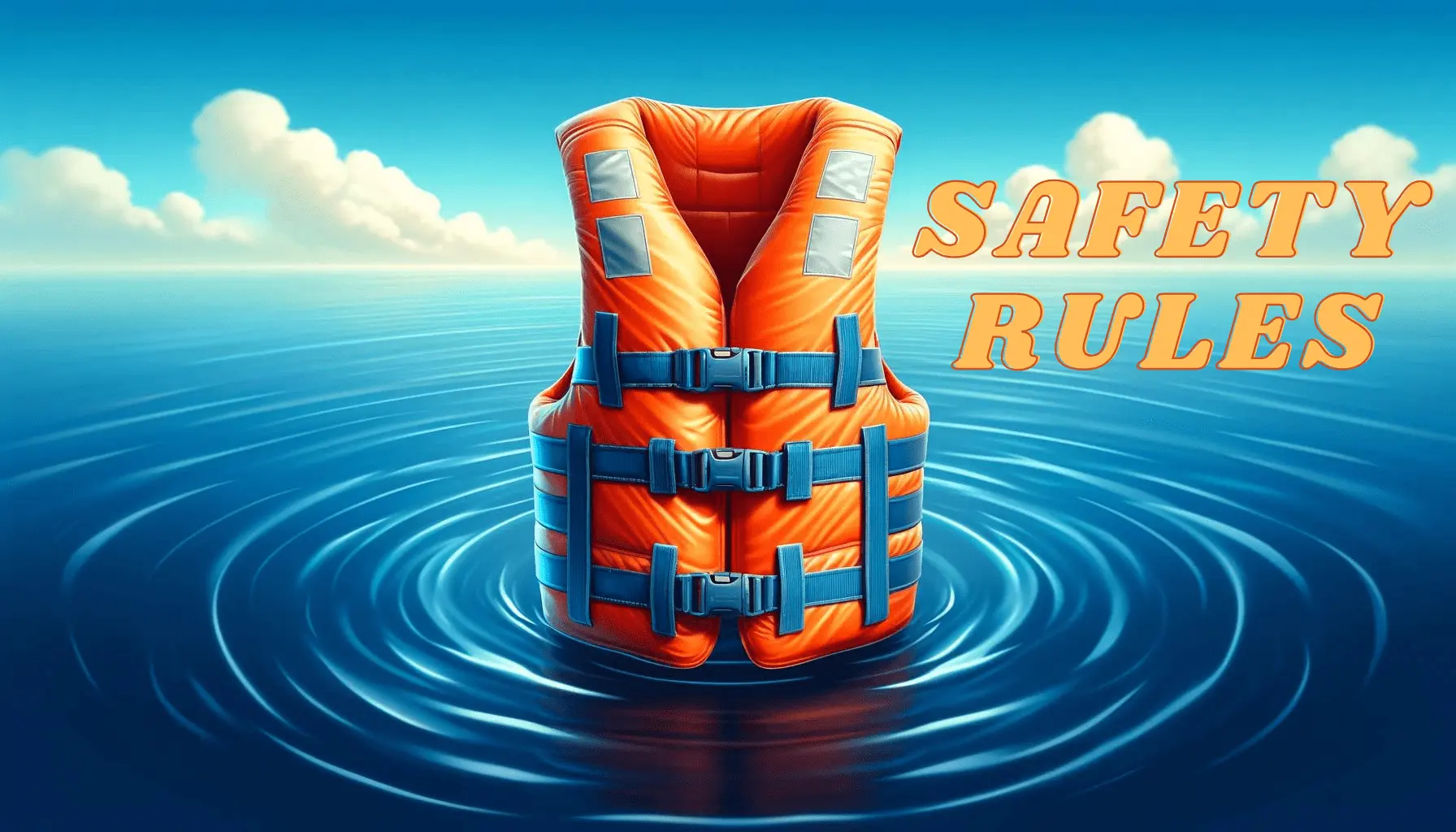Kayak angling is a thrilling sport. It brings together the pleasure of quietly moving on water and the excitement of catching fish. However, there’s a challenge—how to keep your catch fresh while you continue fishing? This leads us to explore kayak fishing techniques for this problem. A fish stringer is a simple, yet powerful tool for kayak fishers. It helps keep fish fresh by connecting them to the kayak while you fish for more. This method creates a link between keeping your catch fresh and your fishing adventure.
Key Takeaways
- Discover the low-cost method of using a fish stringer to maintain freshness during kayak fishing escapades.
- Learn the seamless integration of fish stringer use into your existing kayak fishing techniques.
- Understand the convenience of keeping your catch alive in the water without interrupting your angling rhythm.
- Gain insight on the attachment process for securing a fish stringer to a kayak.
- Explore why mastering stringer use is essential for elevating your kayak angling practice.
Essential Kayak Fishing Gear: Introducing the Fish Stringer
Any angler knows the importance of the right gear for kayak fishing. A key item that significantly helps is the fish stringer. It’s simple but crucial for keeping your catch fresh while you move across the water.
What is a Fish Stringer?
A fish stringer is a device for holding your catch safely in the water. It usually consists of a line with loops or clips, plus a way to attach it to the kayak. Fish are placed on the stringer through their gills, keeping them fresh longer.
Diversifying Your Kayak Fishing Experience with Simple Tools
For both new and experienced kayak fishermen, the right fish stringer is key. Stringers vary in material and design:
- Polyethylene stringers – these are budget-friendly and come with a metal loop. They’re perfect for shallow water fishing.
- Metal clip stringers – these offer easy fish attachment and release. Ideal for when the fish are biting well.
- Heavy-duty stringers – made for catching big fish. They ensure that you don’t lose a great catch.
Each fish stringer type has its own benefits. They make your fishing trips easier by keeping your catches fresh. Picking the right kayak fishing gear, such as a durable fish stringer, is a smart choice. It lets you enjoy fishing without worrying about your catch’s freshness.
How to Use a Fish Stringer on a Kayak
Getting better at kayak fishing tips helps you catch more fish. It’s key to learn how to use a fish stringer on a kayak. A strong point on your kayak, like the front or back, is where you tie one end of your stringer. Making sure it’s securely tied is vital. You wouldn’t want your fish to escape into the water.
To string a fish, pass the stringer through its gills and out its mouth. This helps the fish breathe. Then, using a hook or clip, attach the fish and lower it back into the water. It’s important to keep the fish alive and well, but also tightly secured to your kayak.
- Find a strong anchor point on your kayak for the stringer.
- Insert the stringer’s loop or clip through the fish’s gill slits, then out its mouth.
- Make sure the fish is back in the water, alive and fresh.
- Go on with your kayak fishing, adding more to your stringer as you catch them.
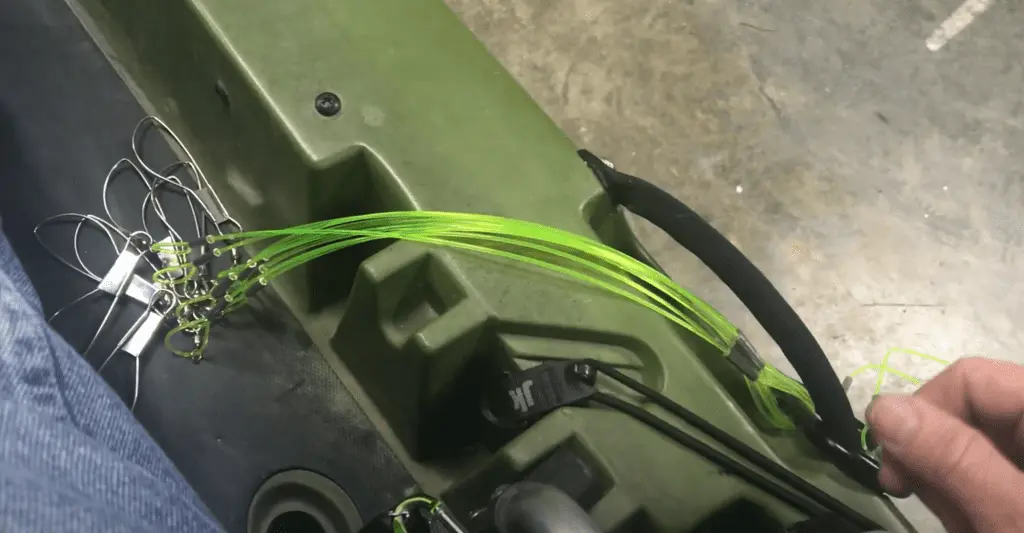
Using these essential kayak fishing tips on how to use a fish stringer on a kayak can change how you fish. This technique keeps the kayak deck clear for fishing. Plus, it keeps your catch fresh for the whole trip. Just make sure to check local rules to see if using stringers is okay where you’re fishing.
Always keep safety and ethical practices in mind when fishing from a kayak, respecting the environment and the wildlife within it.
Selecting the Right Fish Stringer for Your Kayak Fishing Trip
Fishing from a kayak is both peaceful and thrilling. The right gear, including a good fish stringer, is key to success. This gear helps manage and keep your catch secure.
The Versatile Polyethylene Stringer
Durability and cost-effectiveness are big pluses of polyethylene stringers. They’re light, which is great for kayaks. They work for many fish sizes, offering a secure way to keep your catch.
Stainless Steel Clip Stringer Advantages
Stainless steel clip stringers are both strong and easy to use. They’re ideal for saltwater, resisting corrosion. The clip design makes attaching fish quick, letting you fish more.
Heavy Duty Stringers for Larger Catches
If you’re after big fish, you need a heavy-duty stringer. These can handle the weight and movement of large fish. They ensure your catch stays attached, giving you peace of mind.
Specialized Stringers for Easy Kayak Angling
The ForEverlast G2 Pro Stringer is built for kayak fishing. It has floats and snag-free cables. These features consider the unique challenges of kayak angling, offering functionality and practicability.
The right fish stringer makes a difference in kayak fishing. Choose based on your needs, whether it’s for versatility, durability, or handling big catches. Picking the right one will boost your fishing success and enjoyment.

Maximizing Your Kayak’s Space: Storing the Catch
Kayak fishermen value every inch of their space. This is crucial for storing the catch securely and efficiently. With the right kayak fishing gear, they can make the most of their space. This is while following the best practices of fishing from a kayak.
Pros and Cons of Using a Fish Stringer from a Kayak
Using a fish stringer can change the game for kayak fishermen. It’s a neat way to keep your catch fresh. It does this by hanging off the side of the kayak in the water. This saves onboard space for more gear. Indeed, the best fish stringer for kayaking mixes easy use with peace of mind.
- Pros:
- Saves valuable space onboard
- Keeps the catch fresh in the water
- Simple and user-friendly
But, it’s important to know the downsides:
- Cons:
- May reduce kayak’s speed and agility
- Could attract predators
- Possible tangling in dense water plants
When to Consider Alternative Fresh Keeping Methods
Even though a fish stringer works well, sometimes you’ll need other methods. Think about using them if you’re on long trips. Or if you’re fishing where predators are. Or maybe your catch is just really big.
“A fish stringer can be great for many kayak anglers. Yet, sometimes, the water conditions make us look for other ways to keep our catch fresh.”
- In shark-heavy waters, using a cooler or fish bag is safer.
- If your catch is big, a suitable kayak cooler is necessary.
- For keeping fish fresh on long trips, an insulated fish bag with ice is best.
In conclusion, being flexible and ready with various kayak fishing gear helps. This way, you’re always prepared with either the best fish stringer for kayaking, or the right alternative to keep your catch fresh.
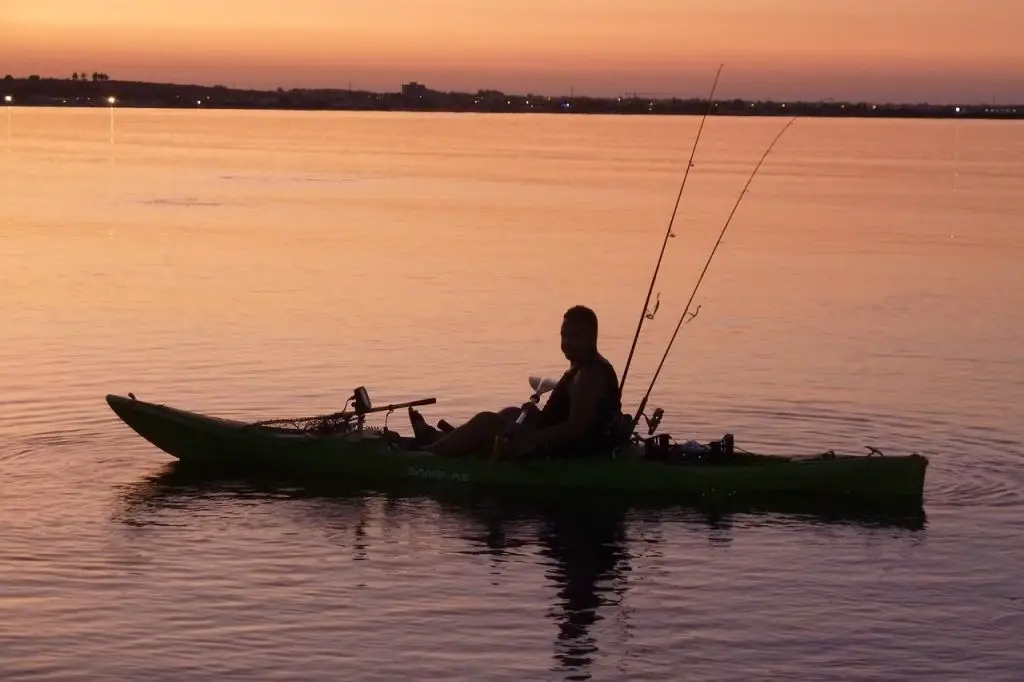
Crafting a DIY Fish Stringer for Personalized Kayak Fishing
Entering the scene of kayak angling lets you adapt your equipment to your own style and needs. The idea of making a DIY fish stringer stands out among kayak fishing tips. It’s loved for its practical use and the freedom to customize.
With a homemade fish stringer, you mix usefulness with a personal flair. You can pick from different materials like tough aluminum or classic bamboo. Anglers get to make a stringer that fits perfectly with their fishing ways.
If you decide to make your own stringer, keep your safety and your catch’s safety in mind. It should be strong, not get tangled, and be simple to manage with one hand.
Crafting your own DIY fish stringer lets you focus on specific needs. It’s also a chance to be inventive and resourceful. Here’s what the making involves:
- Choosing the stringer’s main part, which can be either a metal rod or bamboo.
- Adding rings or loops, crafted from steel or tough synthetic stuff, to hold fish.
- Adding a strong point to connect the stringer to your kayak.
- Putting things like corks or foam on it to keep it floating if it slips away.
- Ensuring the edges and surfaces are smooth to protect the fish.
Why go homemade? Besides saving money, making a DIY fish stringer adds a special thrill to kayak angling. You feel proud knowing you’ve made a useful item that’s truly yours. It’s about the mix of being practical, creative, and the happiness of DIY in kayak fishing.
Conclusion
Kayak fishing is better with the right techniques and tools. Using fish stringers helps anglers keep their catch fresh. It also makes the best use of the limited space on a kayak. There are many kinds of fish stringers available. Or, you can make a personalized one yourself. This creativity is what makes kayak fishing fun.
Choosing the best fish stringer for kayaking is a big decision. It affects your success and fun on the water. There are stringers that float and don’t get tangled, making them safe and easy to use. There are also strong stringers for bigger fish. Having the right stringer for the situation helps keep your catch in good condition. It also makes you feel more prepared and adaptable.
Kayak anglers know that having the right knowledge and gear is important. Using the best fishing techniques and gear like fish stringers makes every trip better. It also lets you customize your gear to suit your style. This way, kayak fishing becomes a sport full of discovery and success. Each trip on the water is an adventure, adding to your story as an angler.
FAQ
What are the basics of kayak fishing techniques using a fish stringer?
When kayak fishing with a fish stringer, first secure it to your kayak. Then thread the fish through their gills and mouth onto the stringer. This keeps them fresh in the water while you fish.
What is a fish stringer and why is it important for kayak fishing?
A fish stringer is a tool that keeps your caught fish alive and tethered to your kayak. It’s key for kayak fishing as it saves space and lets you keep fishing smoothly.
How can fish stringers diversify my kayak fishing experience?
Fish stringers, simple yet effective, don’t need extra space or gear. They vary in material and size, offering various options for different fishing styles.
How do I properly use a fish stringer on a kayak?
To use a fish stringer, attach it firmly to your kayak. Then, put the fish on the stringer by inserting it through their gills and mouth. Ensure it stays underwater so your catch remains fresh.
What type of fish stringer is best for kayak fishing?
The ideal fish stringer depends on the fish you’re after and your preference. Polyethylene stringers are light and affordable. Stainless steel clip stringers allow quick attachment. Heavy-duty ones hold bigger fish. Some stringers have extra features for better fishing.
What are the benefits of using a polyethylene stringer?
Polyethylene stringers are light, bendable, and cheap. They work well for kayak anglers managing smaller fish.
What advantages do stainless steel clip stringers offer?
Durable stainless steel clip stringers make clipping fish easy. They are favored for their strength and convenience.
Is a heavy-duty fish stringer necessary for larger catches?
Yes, a heavy-duty fish stringer securely holds big fish. It’s essential to avoid losing your catch if you’re after large fish.
What are specialized stringers and how do they enhance kayak angling?
Specialized stringers, like the ForEverlast G2 Pro Stringer, have floats and smooth cables. They make fishing easier and prevent tangling, designed for the kayak angler’s specific needs.
What are the pros and cons of using a fish stringer from my kayak?
Fish stringers save space and keep fish alive but can slow the kayak and attract predators. They’re great for saving space but consider the fishing environment’s risks.
When should I consider alternative methods to a fish stringer for keeping my catch fresh?
Use coolers, fish baskets, or insulated bags if you need to keep fish cold longer. If predators are a concern or you prefer not trailing fish, consider these alternatives.
How do I create a DIY fish stringer for kayak angling?
For a DIY fish stringer, pick a durable material suited to the water, like steel or bamboo. Make one with rings, hooks, or clips strong enough for your fish.
